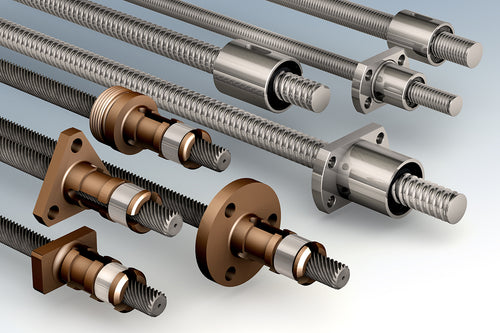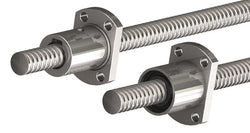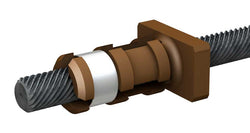
Lead Screws & Ball Screws
The constant force technology utilized in our anti-backlash lead screw nuts results in a greater consistency in performance and life, with great resistance to backlash. Miniature ball screw assemblies have a range of leads with small screw diameters for high precision linear moti... More About Lead Screws & Ball Screws
Browse Categories
The constant force technology utilized in our anti-backlash lead screw nuts results in a greater consistency in performance and life, with great resistance to backlash. Miniature ball screw assemblies have a range of leads with small screw diameters for high precision linear motion.
- Offered with a variety of diameters, leads and nuts
- Precision-Rolled screws tested for straightness and accuracy
- Driven screws with PowerPlus motor technology for 25% - 40% more torque
- Lead screw and ball screws are ideal for laboratory machines, medical devices, mechatronic applications and more.
FAQ - Leadscrew and Ballscrew Motors
When people talk about leadscrew or ballscrew motors, they are referring to an assembly where a motor and leadscrew/ballscrew are joined together by the manufacturer. Most often, the motor is a stepping motor, but in some specialized cases, servo motors can be used. These can be configured such that the screw rotates, and a nut makes a linear movement, or the nut rotates and the screw makes a linear movement.
The choice of a ballscrew motor over a leadscrew motor really comes down to linear motion requirements. Ballscrews have higher efficiency, lower drag, and can generally produce higher forces in the same package size. Leadscrews are often self-lubricating and quieter and can be less expensive. Leadscrew systems can be self-locking, which is sometimes an advantage for vertical applications. Ballscrews are never self-locking.
No… the motors used in a leadscrew or ballscrew motor have been customized in a couple of important ways. First, great care is taken to design a bearing system that can accommodate thrust loads and provide appropriate linear stiffness. Standard motors are designed for radial loads and rotational movement. Second, the inner components of the motors have been redesigned to allow packaging of the screw or nut interface. Standard motors do not have the right internal components to allow for packaging of a screw or nut.
A leadscrew or ballscrew motor can be a critical component of a linear motion system, but it can't do the job alone. In most cases, some sort of linear guide or linear bearing system is needed to support system loads. Depending on the length of travel needed, a radial bearing could be required to support the end of the screw. Drive and control electronics are needed. In many cases, external sensors are used for end-of-travel and homing applications.
The main benefits are package size, cost, and reliability. If you buy separate components, you will need to also use a coupling of some sort along with various brackets and machined parts. The cost of all those components adds up quickly, and they also create opportunities for failures over time. All those components also increase the complexity of a bill of materials and many more parts to manage in production… another source of higher costs that will impact your business for years to come. Integrating a screw with a motor minimizes the size of a mechanical design, simplifies assembly, reduces cost, and improves reliability.
A leadscrew motor would be better in that application. A ballscrew-based system is great in a lot of places, but it needs to be lubricated, and it has open pathways for recirculating the balls. Paper dust can mix with the lubricant and have a serious negative impact on life.
Theoretically, there is no limit as the concept is to simplify the interface between the screw and the motor… however, from a practical standpoint, we think about 1-1.5 meters as the longest practical length. Manufacturing processes, packaging, shipping, and assembly come into play. There are also system issues with any screw-based design in terms of column strength, critical speeds, etc., that need to be taken into account.
The answer to that is … it depends. The motors themselves never need to be lubricated. They use permanently lubricated ball bearings. Leadscrews using the right type of nut do not need to be lubricated. Ballscrews, on the other hand, will need to be lubricated at initial install and periodically over the life of the product… typically at least once a year depending on the application.
Either a leadscrew motor or a ballscrew motor is designed to create thrust loads along the central axis of the screw. They are not designed to handle side loads. You will have to develop some system to take up radial loads. The details of that design will depend on your application, but common approaches include profile rail, cam roller-based systems, and round rail-based systems using either ball bearings or precision plain bearings such as Simplicity.
You can remove the nut from a leadscrew to facilitate your assembly. If it is preloaded, just be careful with the preload adjusting spring. Ballscrews are a different story… in general, you should not remove the nut from a ballscrew if you can avoid it. It is possible to remove a ballnut from the screw using special tools and fixtures, but this should only be done by skilled and trained technicians.






















